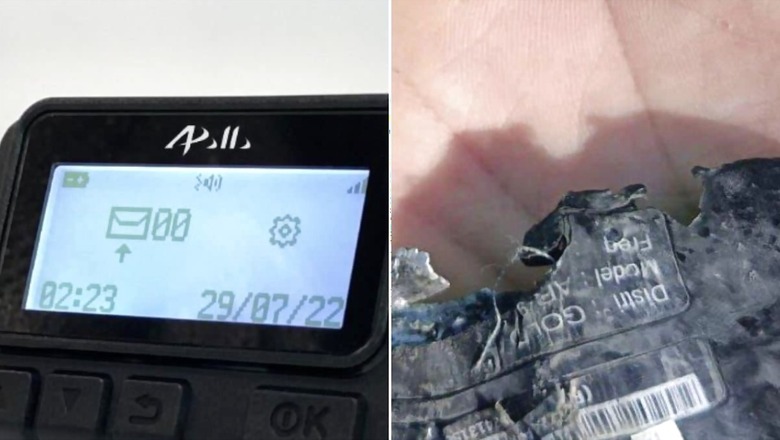
views
Rising Threat of Embedded Explosives in Electronic Equipment: A New Form of Warfare?
In today’s rapidly evolving technological landscape, the very devices we rely on for daily convenience, communication, and commerce could pose unexpected and catastrophic threats. Recent attacks involving Hezbollah, supposedly carried out by Israel, demonstrate how electronic equipment may be tampered with, embedding life-threatening explosives within their core components. This growing concern raises critical questions about the security of electronic devices, the evolution of warfare, and the safety of civilian consumers.
The Danger of Embedded Explosives in Electronics
As we witness unprecedented advancements in electronics, we are also beginning to see the darker side of this technological revolution. Modern electronic devices, from smartphones to military-grade drones, often rely on compact, powerful batteries to function. This reliance on batteries presents an alarming vulnerability—one that malicious actors could exploit by embedding explosives within them.
Take, for instance, the development of lithium-ion batteries, which are widely used due to their high energy density and lightweight nature. These batteries, however, have already shown the potential for volatility, as seen in the infamous case of Samsung Galaxy Note 7 devices, where design flaws caused batteries to overheat and, in some cases, catch fire. Now, imagine if such an occurrence wasn’t the result of a manufacturing defect but a deliberate act of sabotage.
In a hypothetical yet plausible scenario, a new consignment of electronic equipment, destined for a military base or civilian infrastructure, could include seemingly ordinary batteries that have been modified to contain explosives. These batteries could either be programmed to detonate at a specific time or triggered remotely through software embedded within the device. Such a scenario could cause significant loss of life, disrupt critical systems, and instill widespread fear.
Another real-world example of the potential for embedded explosives comes from the infamous “printer cartridge bomb” plot in 2010, where explosive devices were hidden within the cartridges of printers being shipped on cargo planes. While this plot was foiled, it serves as a chilling reminder of how everyday objects can be turned into deadly weapons.
The Imperative of Thorough Inspections
Given the dangers posed by tampered electronics, it is absolutely essential to thoroughly inspect every aspect of any electronic device before it is inducted, whether for civilian or military use. The threat is not merely theoretical but grounded in reality, as evidenced by past terrorist plots and emerging technological vulnerabilities.
Consider the vast array of electronic devices that are imported globally every day. Many of these devices come from manufacturers in regions with varying degrees of regulatory oversight. While large corporations like Apple or Samsung have strict quality control protocols, there are countless smaller suppliers whose products may not undergo the same level of scrutiny. If even one compromised device makes it through the supply chain undetected, the consequences could be dire.
Military contractors and defence agencies, in particular, must be vigilant. In 2018, the US military discovered that Chinese-manufactured microchips, which were used in critical systems, had backdoor vulnerabilities that could allow remote tampering. If such microchips were also rigged with explosives, the result could’ve been catastrophic. This underscores the need for comprehensive testing and validation of all components before they are deployed in sensitive environments.
Moreover, even in a civilian context, devices that are not rigorously inspected can cause harm. In 2017, a wave of malware known as “Petya” spread globally, disabling thousands of computers in businesses and government offices. While Petya did not physically damage hardware, it illustrated how easily software vulnerabilities could be exploited on a massive scale. Now, imagine if such vulnerabilities were combined with physical explosives hidden within the hardware. The potential for harm grows exponentially.
The Emergence of Hardware-Software Combo Warfare
One of the most alarming developments in modern warfare is the convergence of hardware and software as weapons. Historically, warfare was fought with physical weapons—guns, bombs, tanks, and planes. In recent decades, cyber warfare has emerged as a powerful tool, with hackers targeting critical infrastructure, financial systems, and government databases. However, we are now entering an era where the lines between physical and digital attacks are blurring, leading to a new form of warfare: hardware-software combo attacks.
This emerging form of warfare can be exemplified by the Stuxnet virus, which was first discovered in 2010. Stuxnet was a piece of malicious software that targeted the industrial control systems of Iran’s nuclear facilities, causing physical damage to centrifuges. This was one of the first instances where software was used to cause real-world, physical destruction.
Now, imagine a similar attack, but with the added element of explosives embedded within the hardware. In this scenario, malicious software could trigger the detonation of an explosive embedded within a critical piece of electronic infrastructure—be it a server, a drone, or even a communication device. This hardware-software combo could enable attackers to cause not just digital disruption, but physical devastation on a massive scale.
For example, consider a military base receiving a shipment of advanced drones from an overseas supplier. The drones appear to function normally, passing initial inspections and being deployed for reconnaissance missions. However, unbeknownst to the military personnel, the drones contain hidden explosives within their battery compartments. At a critical moment, the enemy activates a software trigger, causing the drones to detonate mid-mission, taking out key personnel and equipment.
Could this spiral into a larger, more sinister design?
As the potential for embedded explosives in electronic equipment becomes more apparent, there is growing concern that this tactic could spiral into a larger, more sinister strategy. The weaponisation of everyday devices could extend far beyond military applications and into the civilian sphere, creating a widespread sense of vulnerability and fear.
Consider the proliferation of smart devices in modern homes. From smart refrigerators and thermostats to voice-activated assistants like Amazon’s Alexa, these devices are increasingly connected to the internet and integrated into daily life. What if malicious actors begin targeting these devices, embedding explosives or other harmful elements within them? The potential for chaos is immense, as millions of households could suddenly find themselves at risk from the very devices that are supposed to make their lives easier.
Additionally, the combination of hardware and software vulnerabilities could be used to target critical infrastructure. Power grids, water treatment plants, and transportation systems all rely on complex networks of electronic devices to function. If these devices were compromised with embedded explosives or malicious software, entire cities could be brought to their knees in a matter of minutes.
The rise of this new form of warfare also raises ethical questions. As more and more devices are produced with the potential for dual-use—both civilian and military—how can governments and regulatory bodies ensure that they are not weaponised? The international community will need to come together to establish new norms and standards for the production and inspection of electronic devices, or risk facing an unprecedented wave of destruction.
Are Civilians Safe?
Finally, the question that looms large for most people is whether civilian consumers are safe when using everyday electronic devices like smartphones and laptops. The short answer is: for now, yes, but with caveats. While there have been no widespread instances of consumer electronics being weaponised, the possibility is real, especially as malicious actors become more sophisticated in their tactics.
For example, the battery explosion incidents in the Samsung Galaxy Note 7, though caused by a design flaw, provide a glimpse into the potential dangers of tampered electronics. If a major corporation with rigorous safety protocols can accidentally produce a device capable of causing harm, it’s not difficult to imagine what a determined adversary could do with malicious intent.
Innocent consumers may also be at risk due to the growing presence of counterfeit or low-quality electronics in the market. Many of these devices are produced with little oversight, making them easy targets for tampering. A report by the Organisation for Economic Cooperation and Development (OECD) found that nearly 3.3 per cent of world trade involves counterfeit goods, with electronics being one of the most commonly faked items.
In the event that hardware-software combo attacks extend to consumer devices, civilians could find themselves in the crossfire of a much larger geopolitical struggle. Regulatory agencies and manufacturers must work together to ensure that the devices people use every day remain safe, both from accidental malfunctions and malicious exploitation.
Conclusion
The potential for embedded explosives in electronic equipment, combined with the rise of hardware-software combo warfare, represents one of the most alarming developments in modern conflict. As technology continues to evolve, so too do the methods by which it can be weaponised. Thorough inspections, greater scrutiny of electronic imports, and advancements in detection technology will be essential to preventing these threats from becoming a reality.
As we move forward, the world must remain vigilant, ensuring that the conveniences of modern electronics do not become instruments of terror. In the end, the safety of both military personnel and civilians depends on our ability to stay one step ahead of those who seek to exploit the very devices we rely on every day.
Group Capt MJ Augustine Vinod VSM (retd) tweets at @mjavinod. Views expressed in the above piece are personal and solely that of the author. They do not necessarily reflect News18’s views.



















Comments
0 comment